|
A heat pump is a refrigerant system, much like an air conditioner or refrigerator, that can both heat and cool your home. Most heat pumps are split systems, with an outdoor coil, an indoor coil and a compressor. During the winter, the system extracts low-grade heat from outdoors and transfers it indoors. During the summer, the heat pump is reversed, absorbing unwanted heat from indoors and sending it outdoors. A thermostat, ducts and blowers control and distribute the warm and cool air. Although it's hard to imagine squeezing any useful heat energy from 30°F (-1°C) wintertime air, a refrigerant at -20°F (-2 9°C) will be warmed when circulated through the outdoor coil in air that's 50°F (2 7°C) warmer. During this cycle, the compressor and fans consume energy to deliver the heat. The ratio of the amount of heat delivered to the amount of energy consumed is called the coefficient of performance (COP). Depending on the outdoor temperature, the COP of a good heat pump in the heating season ranges from 1.0 to 3.0—meaning 1 to 3 BTUs of heat delivered per BTU of electricity consumed. Most heat pumps are slightly more efficient during the cooling season. Other rating systems used for heat pumps are the heating season performance factor (HSPF) and the season energy efficiency ratio (SEER). These ratings use the watt as a unit of measure and are simply 3.4 times the size of the COP because there are 3.4 BTUs per watt. As outdoor temperatures fall, a heat pump’s heating capacity declines, although high-quality units can still extract heat with outdoor temperatures as low as 9°F (-13°C). To compensate, supplementary electric heating elements switch on at the crossover point, which is the point at which an air-source heat pump does not have enough heating capacity to satisfy a home’s needs. Have a heat pump serviced annually by a qualified contractor. In addition, routinely vacuum the indoor coil, change the blower filter and wash the outdoor coil with a hose. |
Diagram of Heating Cycle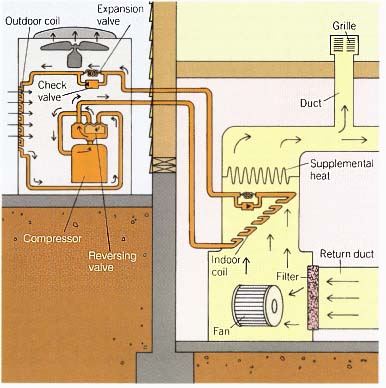 In heating cycle, refrigerant passes through outdoor coil as gas, drawing heat from air. Gas moves to compression where high pressure raises its temperature. Compressed gas moves to indoor coil, where it releases heat and condenses into liquid. Expansion valve allows liquid to move from high pressure to low, lowers temperature and vaporizing again. For cooling, a valve reverses the system. 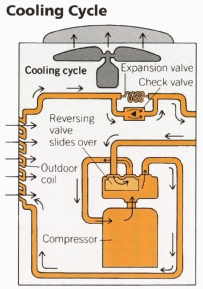 |


Heat Pump Troubleshooting
Problems (Symptoms) |
Potential Solutions |
Frost on outdoor coil in winter and on indoor coil in summer; irregular defrosting patterns. |
Buildup is a normal function of humidity, temperature and coil design. Keep coils and condenser clean. Replace filter because more airflow reduces defrost cycle length. If problem persists, check manual to locate and clean airflow sensing tube. |
Refrigerant leaking red dye. |
Call for repair. If unattended, a leak can lead to compressor failure. |
Odors when heat pump kicks on. |
Check that drip pan, which catches condensate from indoor unit, is draining. |
Inadequate heat in very cold weather. |
Unit may be undersize. Shut off vents in unused rooms. Consider adding duct boosters or auxiliary heaters. Supplementary heating coil may need replacing. |
Frequent on-off cycling. |
Check thermostat; it could be broken or have an improperly set anticipator. |
Cold air from register blowing onto frequently used seating places. |
Adjust diffusers to direct air away from seating; seal any ductwork in attic or crawl space; have in-line supplementary heater installed in problem duct. |
Frequent compressor burnout. |
Mismatched indoor and outdoor units. Have contractor evaluate system as a whole. |
Water-Based Heat PumpsMost heat pumps extract heat from the air, but some use heat from water for heating or cooling. In a water-based sys tem, the pipes may be submerged in a lake or stream. But, since groundwater temperatures vary less than lake and stream water, the most common type uses well water brought to the heat pump and either discharged or re-injected into another well, as shown below. Though much more expensive to install, heat pumps that rely on ground and water temperatures are vastly more efficient than air systems, because ground and water temperatures don’t go to the extremes of air temperatures. Check local building codes about regulations in your area. |
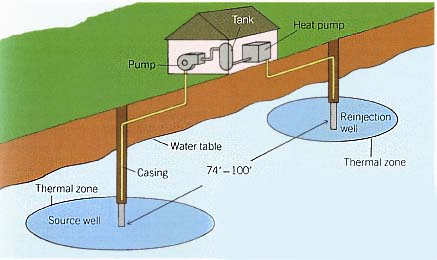 Diagram (above): In some water-based systems, well water brought to the heat pump and then either discharged or re-injected into another well. In other systems, fluid is pumped through piping that's submerged in a lake or stream. |
Ground-Source Heat PumpsGround-source heat pumps, also called geothermal systems, tap into the huge storehouse of energy contained in the earth by removing heat stored in the soil and transferring it into your house, making these systems extremely efficient. Whereas the best gas furnaces run at 92-percent efficiency, geothermal units run at a whopping 300-percent efficiency, because they’re tapping into and transferring existing heat rather than burning fuel to create it. Geothermal systems have three main components: the ground loop that gathers heat, the heat pump that condenses the heat and the duct system that distributes the heat. The ground loop can be one of two varieties. Closed-loop systems circulate an antifreeze solution through polyethylene pipe buried at least 6 ft. (2 m) underground, where year-round temperatures hover at around 55°F (13°C). Open-loop systems rely on a supply of water, usually well water, rather than antifreeze. Water is circulated through the heat pump, heat is extracted and the cooled water is discharged, usually to a pond. The heat is absorbed by a refrigerant, which is compressed and rises in temperature to about 160°F (71°C). Air passing over a heat exchanger is warmed and distributed throughout the home through a network of ducts, similar to a forced-air system. |
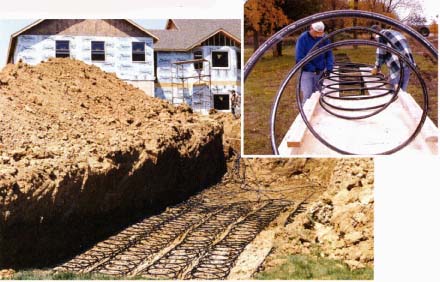 Geothermal pipe, shown above, can be buried in trenches, circulated beneath ponds or run in a series of deep, vertical well holes. The pipe can be installed in straight, parallel lines or coiled like a Slinky toy. The earth warms the antifreeze mixture or water, the heat is withdrawn by the heat pump and the cycle repeats. The earth around the pipe slowly cools, but never to the point that the system stops working. Summer sun reheats the earth for the next heating season. |
Helpful Hints: Improve EfficiencyAn air screen greatly improves a heat pump’s cooling efficiency in the summer, especially in warm, humid climates. It shades the outdoor condensing coil to make it possible for the cooling coil to dissipate heat faster. In the winter, remove the screen to better capture the sun’s warming rays. |
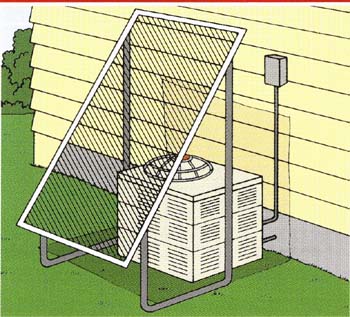 |
